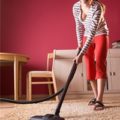
As many Americans prepare for a season of cold weather, allergy sufferers are undoubtedly preparing the interior of their homes to be sealed up from inclement weather, promote good air quality and reduce the chance of reaction throughout the next few months.
Indoor allergens are a prominent issue for allergy sufferers around the globe. Approximately a quarter of Americans suffer from some type of allergy, and of those individuals, one-half to two-thirds are also more sensitive to dust mites than the rest of the population. If you think you might have a dust mite allergy, the best first step is to consult with an allergist about your symptoms and potential remedies.
The next best course of action is to replace your bedding with clean, hypoallergenic sheets and pillow covers that will reduce the impact of dust mite waste or body parts on your system. If you have taken these two initial steps to reduce your symptoms, allergists have offered up a slew of other ideas for how to handle the pesky reactions that plague you:
Ditch drapes – In a recent post, we talked about how ripping out carpet can actually be detrimental for your health because in some cases it will act as a filter and trap particles that can cause airborne allergy reactions. But heavy drapes do not offer this kind of benefit, so it is best to do away with them altogether. Not only are they really hard to clean – usually they need to be dry cleaned, which many homeowners don't do as regularly as is necessary – but they also are a safe haven for dust mites. If you need to have draperies in the dining or living rooms, that may be fine, but they should certainly be removed from your bedroom where you spend a good amount of time.
Dry – Moisture can cause all kinds of respiratory issues for people who suffer from allergies. So installing a humidifier or vaporizer can actually do more harm than good. Additionally, if you are trying to reduce the presence of dust mites then reducing the humidity in your home is a good place to start. The little buggers can't live in less than 50 percent humidity.
Encase – Even if you have a hypoallergenic mattress, it's not going to do you any good if dust mites or other allergens are able to burrow into the seam or pockets. Be sure to encase your mattress, box spring, pillows and comforters in a well-sealed, microfiber cover that will allow you to eliminate the impact of bedroom allergens. It is also really important to wash these items weekly so you remove any built-up particles.
Keep it clean – "To help keep indoor allergens of any kind at bay, homes should be smoke-free and pets should be kept out of the bedroom. For the very allergy-prone, use a HEPA air filter in the bedroom with a CADR (clean air delivery rate) adequate for the size of the room. Install MERV 11 or 12 disposable, high-efficiency filters in the furnace and air conditioning system that can be changed every few months," writes the Charlotte Observer.
Smooth – While textured surfaces may make the aesthetic of your home more interesting and exciting, they can actually harm your health and make it hard for your to live in the space. If you can, opt of smooth surfaces, which are easier to clean.
When it comes to maintaining a safe and healthy home, being sure that you have all the preventative materials for allergy control is key. For more information on how Allergy Be Gone can help, contact us today!









